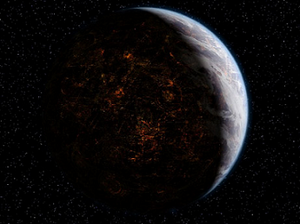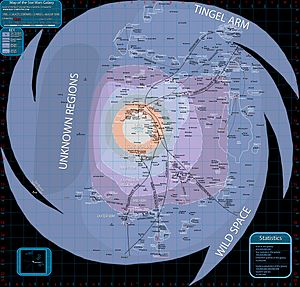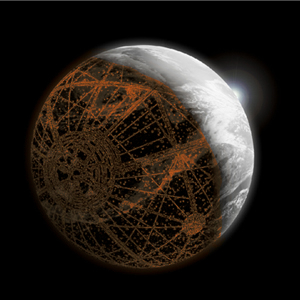Coruscant facts for kids
Quick facts for kids Coruscant |
|
|---|---|
 |
|
| Star Wars location | |
| Created by | George Lucas, Timothy Zahn |
| Genre | Science fiction |
| Type | Urban (planetwide ecumenopolis) |
| Race(s) |
|
| Population | 2 trillion (68% Human, 32% other sentients) |
| First appearance | Heir to the Empire (1991) Canon (live-action): Return of the Jedi (1997 special edition) |
| Last appearance | The Mandalorian (2023) |
| Moon(s) | 4 (Centax-1, Centax-2, Centax-3 and Hesperdium) |
| Oceans | 0 |
| Sun(s) | Coruscant Prime |
| Grid Coordinates | L-9 |
Coruscant is an ecumenopolis planet in the fictional Star Wars universe. It was first described in Timothy Zahn's 1991 novel Heir to the Empire, and made its first on-screen appearance in a scene added to Return of the Jedi for its 1997 re-release. It has gone on to become an important location in the Star Wars universe and appears frequently in Star Wars media.
In-universe, Coruscant is a politically and strategically important planet, serving as the capital and seat of government for the Republic and Empire, as well as the headquarters of the Jedi Order. It is typically depicted as a bustling yet highly stratified planet-spanning metropolis. Throughout the city's centuries-long development, new city blocks were built on top of old ones, forming levels. Coruscant has 5127 levels, with the 5127th being the wealthiest and 1st being the poorest.
Coruscant has four moons and is the sixth planet out of the 11 that make up the system of the same name. It lies within the Coruscant Subsector of the Corusca Sector, located in the Core Worlds galactic quadrant region. The sun, Coruscant Prime, is the zero coordinate of the Star Wars galaxy (as opposed to its galactic center). In Legends, Coruscant was once referred to as Notron or Queen of the Core. It was renamed Imperial Center during the reign of the Galactic Empire (as depicted in the original films) and Yuuzhan'tar during the Yuuzhan Vong invasion (as depicted in the New Jedi Order novel series). The planet's capital city was initially Galactic City (built at least in 100,000 BBY, partially destroyed in 27 and 44 ABY). It was Imperial City under the Galactic Empire and was Republic City (or the City of Spires) under the Galactic Republic. The planet was code-named Triple Zero during the Clone Wars. The demonym and adjective form of the planet name is Coruscanti.
Contents
- Etymology and naming
- Early concepts
- Design
- Appearances
- Episode VI: Return of the Jedi
- Episode I: The Phantom Menace
- Episode II: Attack of the Clones
- Episode III: Revenge of the Sith
- Star Wars: The Clone Wars (2003 and 2008 TV series)
- Rogue One: A Star Wars Story
- Obi-Wan Kenobi
- Andor
- Tales of the Jedi
- The Mandalorian
- Other works
- Notable metropolitan areas
- Theme park attraction
- See also
Etymology and naming
In the Star Wars universe, the planet Coruscant derives its name from a rare and valuable gemstone, the corusca gem (a fictional gem in Star Wars lore). The lights of the planet-wide city, as seen from space, were said to resemble the glittering of these gems.
In the real world, the word “coruscant” originates in the late 15th century from the Latin word coruscant, meaning "vibrating, glittering." It comes from the Latin verb coruscare, meaning “to glitter.” The Concise Oxford Dictionary defines it as a poetic and literary adjective meaning "glittering; sparkling." In French, “coruscant” is also used as an adjective meaning “glittering; sparkling.” As a literary adjective, the French term can be used to describe a decadent and overly complicated language, decorum or community.
Early concepts
The concept of a city planet in the Star Wars universe originated with the initial drafts of Star Wars when author George Lucas included a planet called Alderaan, a city-planet and the capital planet of the galaxy. In Lucas's 1975 draft, Adventures of the Starkiller as taken from the Journal of the Whills, Saga I: The Star Wars, the capital planet of Alderaan is described as a floating city in the clouds, "suspended in a sea of cirrus methane." This concept was illustrated in early sketches commissioned by Lucas from conceptual artist Ralph McQuarrie, and the design very closely resembles Cloud City, the floating city featured in The Empire Strikes Back. In Lucas's third draft, the Imperial City of Alderaan became the home world of the Sith Lords, where Darth Vader held Princess Leia captive. Lucas continued to hone his script, aided by screenwriters Willard Huyck and Gloria Katz. By the fourth draft, scenes on the Imperial capital planet had been moved to a space station called the Death Star and the name of Alderaan was given to a peaceful world destroyed by the Empire. The Empire's homeworld, Had Abbadon, came up in early drafts of Return of the Jedi. The entire planet was to be a sprawling city. However, concluding that the realization of such a city was impossible at the time, the creators abandoned the idea. Later, in the graphic novel Legacy 29: Vector, Part 10 the name Had Abbadon was given to a lost mythic planet in the Had Abbadon System of the Deep Core. This mythic planet was covered by dry fields, linked to the birth of the Jedi, and the location of a planned assassination attempt by Cade Skywalker on Darth Krayt. It was also the home to an Imperial.
The Empire's homeworld first appeared in the Star Wars Expanded Universe and was called Coruscant for the first time in Timothy Zahn's Heir to the Empire.
In various novels, characters aligned with the Empire refer to Coruscant as "Imperial Center". Within the stories, this is explained as an administrative renaming undertaken to emphasize the differences between the Old Republic and the Empire.
Coruscant was in some early sources called "Jhantor" in homage to Isaac Asimov's Trantor.
Design
Production artwork produced by Ralph McQuarrie for Return of the Jedi included some unrealized designs for the imperial capital, Had Abbadon. During production of The Phantom Menace, it was decided that scenes would be set on the capital planet, now called Coruscant. Artist Doug Chiang was tasked with designing the imperial city for which he turned to McQuarrie's original concept art. The appearance of the cityscape has been described as a "retro-futuristic metropolis", and the streams of floating vehicles travelling between soaring skyscrapers is thought to have been partly inspired by Fritz Lang's 1927 film, Metropolis.
In Attack of the Clones, the depiction of Coruscant was expanded greatly. Chiang created a more urban, apocalyptic environment for the street level, taking inspiration from Ridley Scott's 1982 film Blade Runner.
Appearances
Episode VI: Return of the Jedi
Coruscant is the location of a sequence added to the 1997 Special Edition release of Return of the Jedi, its first onscreen appearance. The sequence depicts the reaction of citizens of Coruscant upon hearing of the death of Emperor Palpatine, where many citizens are seen celebrating with fireworks and by pulling down his statue.
Episode I: The Phantom Menace
Coruscant was prominently featured in Star Wars: Episode I – The Phantom Menace as the location of the Galactic Republic Senate building and the central Jedi Temple.
Episode II: Attack of the Clones
There is a speeder chase through the skies of Coruscant in Episode II: Attack of the Clones that eventually leads to a nightclub in the bowels of Coruscant's Uscru Entertainment District. Another area of Coruscant shown is Coco Town (short for "collective commerce"). Coco Town is the site of Dex's Diner in Attack of the Clones. Another notable area of Coruscant is 500 Republica, an area where the elites of the city, such as politicians and diplomats, gather.
Episode III: Revenge of the Sith
In Episode III: Revenge of the Sith, Coruscant is featured in a space battle (known as the Battle of Coruscant) during the opening scene. Separatist cyborg General Grievous has kidnapped Chancellor Palpatine and uses the Separatist fleet to help assault the capital and cover his escape.
The planet's cityscape is then prominently featured throughout much of the movie with Chancellor Palpatine's office as well as the Senate building being the primary two settings on Coruscant. A theatre in 500 Republica is where Anakin Skywalker and Palpatine watch a ballet; during the show, Palpatine encourages Skywalker to ally with the Dark Side by telling him of the supposed Sith ability of resuscitation.

After a failed attempt by the Jedi to arrest Palpatine when he divulges his true identity as Darth Sidious to Skywalker, Palpatine appoints himself Emperor of the first Galactic Empire in the Republic Senate Building on Coruscant.
Star Wars: The Clone Wars (2003 and 2008 TV series)
Coruscant features prominently in both the 2003 traditionally-animated The Clone Wars series and the 2008 computer-animated The Clone Wars series, as the headquarters of the Jedi Temple and the senate.
Rogue One: A Star Wars Story
In Rogue One, Jyn Erso has a flashback of her young self on Coruscant.
Obi-Wan Kenobi
In Obi-Wan Kenobi, Coruscant makes its first extensive live-action appearance in the Star Wars saga since the prequel trilogy. Coruscant is prominent in a montage of footage from the Star Wars prequel films, and the Jedi Temple of Coruscant is the setting of several scenes.
Andor
Coruscant is a prominent setting in the Andor series. All of Mon Mothma's scenes take place on Coruscant as well as the majority of Dedra and Syril's scenes.
Tales of the Jedi
In Tales of the Jedi, Coruscant appears prominently in three of the six episodes. Count Dooku and Mace Windu attend the funeral of Council Member Katri at the Jedi Temple, Ahsoka Tano is shown extensively training for combat in the same location, and the final lightsaber duel between Master Yaddle and Count Dooku takes place in Darth Sidious' manufacturing-district lair. In one scene, Dooku remarks upon the fact that Coruscant is a planet of "Steel and Stone", lacking much in the way of wild nature; Qui-Gon Jinn, who was born there, had never seen a tree before visiting the Jedi Temple for the first time as a boy.
The Mandalorian
In the 19th episode of The Mandalorian, Coruscant is featured as a New Republic capital. On Coruscant, we are re-introduced to Dr. Penn Pershing and Elia Kane, a former communications officer on Moff Gideon's cruiser, who are now revealed to be a part of the New Republic Amnesty program.
Other works
Coruscant appears as the background of a space battle in Lego Star Wars: The Complete Saga.
In Lego Star Wars: The Skywalker Saga, players can visit Coruscant's Federal and Uscru Districts.
In the prologue of the comic series Dark Empire (1991), set after the original film trilogy, Coruscant is ravaged by battles between warring Imperial factions.
Coruscant in seen in the X-Wing series of computer games.
Concept art by Ralph McQuarrie served as the basis for the pyramidal Imperial Palace, depicted in The Illustrated Star Wars Universe (1995) by Kevin J. Anderson, which claims it is "the largest structure on Coruscant, perhaps on any planet". According to the Star Wars Encyclopedia (1998), it is located next to the Senate building. Although this version of the Imperial Palace appears in a variety of Expanded Universe works, in canon, the Imperial Palace is located at the site of the former Jedi Temple, where Palpatine resides.
In The New Jedi Order series (1999–2003), Coruscant is the capital world of the New Republic until, in The New Jedi Order: Star by Star, the extragalactic Yuuzhan Vong overwhelm the New Republic defenses in three attack waves led by Warmaster Tsavong Lah who takes over the planet, destroying the New Republic and creating the theocratic Yuuzhan Vong Empire. After surrendering, the Yuuzhan Vong agreed to help the Alliance rebuild Coruscant. The new Coruscant is a combination of technology and organic life representing the peace between the Galactic Federation of Free Alliances (Galactic Alliance) and the Yuuzhan Vong.
James Luceno's novel Labyrinth of Evil (2005) introduces a deserted manufacturing area known as 'The Works' as the meeting place for Sith Lords Darth Sidious (Palpatine) and Darth Tyranus.
With the 2012 acquisition of Lucasfilm by The Walt Disney Company, most of the licensed Star Wars novels and comics produced since the originating 1977 film Star Wars were rebranded as Star Wars Legends and declared non-canon to the franchise in April 2014.
Notable metropolitan areas
Senate District
The Senate District (also sometimes referred to as the Federal District) is located on the planet's equator, containing numerous notable sites such as the Ambassadorial Sector (home to 500 Republica and the Senate Apartment Complex), Embassy Mall, the Coruscant Opera House, the Galactic Museum, the Heorem Complex (Home to the Heorem Skytunnel), Judicial Plaza (home to the Glitanni Esplanade and the Judicial Arcology), the Legislative Borough, Senate Plaza, the Avenue Of The Core Founders, the Republic Executive Building, the Galactic Senate Building, Hospital Plaza, the Galactic Senate, the Palace District (home to the Imperial Palace and Senate Hill), Quadrant A-89 (home to the CSF HQ, the Fellowship Plaza, the Galactic Justice Center and the Temple Precinct (home to the Jedi Temple)), Sector H-52, Sector I-33, the Uscru Boulevard, Westport and Xizor's Palace.
The Senate District is depicted as the de facto capital of Coruscant, the Old Republic, the Galactic Empire, the New Republic, the Galactic Federation Of Free Alliances and the One Sith. It is shown bordering the Financial District and the Sah'c District, and is also adjacent to The Works (an industrial sector on the planet). The senate district is also referred to as the Legislative District, Government District and Government Center.
Alien Protection Zone
The Alien Protection Zone is referenced as a walled ghetto on Coruscant of unknown location, housing the planet's non-human population. Neighborhoods within the zone are shown representing the cultures of these minority groups. The Alien Protection Zone was constructed in 19 BBY by the Galactic Empire and opened by the New Republic in 6 ABY.
Sah'c Town
Sah'c Town, also known as Sah'c District or Quadrant H-46, is an area situated on the Equator, named after and controlled by the wealthy Sah'c family. It was home of an emergency bunker where the chancellor of the Galactic Republic or New Republic ruled in case of emergencies. The area also contains Sah'c Canyon, which serves as the exit point of the Senate District's Heorem Skytunnel.
Uscru District
The Uscru District appears in Attack of the Clones, Revenge of the Sith, and Lego Star Wars: The Skywalker Saga. On its upper levels, it hosts the Galaxy's Opera House. The district's lower levels were collectively referred to as the Entertainment District. The Outlander Club (seen in Attack of the Clones and mentioned in Jedi: Fallen Order) is in the Entertainment District.
Theme park attraction
Coruscant also appears in the theme park attraction Star Tours – The Adventures Continue in Disney's Hollywood Studios in Walt Disney World Resort in Orlando, Florida, and Disneyland Park in Disneyland Resort in Anaheim, California.
See also
 In Spanish: Coruscant para niños
In Spanish: Coruscant para niños


